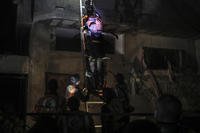China's military will likely have multiple aircraft carriers, thousands of guided cruise and ballistic missiles, next-generation cyber-attack capabilities and fifth-generation stealth fighters by the end of this decade – according to a newly released Pentagon report on China.
The report characterizes the U.S.-China relationship as one containing both cooperation and competition or points of friction between the two countries.
Successful instances of progress with military to military cooperation between the U.S. and China are specified in the annual report to Congress, yet senior Pentagon officials remain concerned about China’s increasingly assertive behavior.
One senior Pentagon official cited China’s continued position regarding unification with Taiwan and its controversial stance on territorial disputes in the South China Sea and East China Sea.
“They are preparing for potential conflict in the Taiwan strait, which includes deterring or defeating third party intervention. That remains the focus and primary driver of much of China’s military investment,” a senior Defense official said.
China’s deployment of short-range ballistic missiles across from Taiwan has continued to grow substantially over the past year, he added. China now has more than 1,000 short range missiles deployed across from Taiwan, the senior official said.
“We highlight and note in this report that those deployments continue. Not only do we see and view missile moving into those areas but they are upgrading and improving the missiles that were there,” he said. “Our policy on Taiwan is clear and consistent – we continue to remain committed to support and provide defense articles and services to enable Taiwan to maintain a sufficient self-defense capability.”
China’s defense spending continues to grow, jumping an average of 9.4 percent per year between 2004 and 2013, according to the report. In March of 2013, China announced an annual military budget of $119.5 billion, a 5.7 percent increase.
Overall, the report details a comprehensive Chinese military modernization strategy which spans a wide range of areas including investments in advanced medium range conventional ballistic missiles, integrated air defenses, long range land attack and anti-ship cruise missile, counter-space weapons and offensive cyber capabilities.
The report also details Chinese investments in advanced aircraft, submarines and surface combatants including aircraft carriers.
The first long-range deployment of China’s lone aircraft carrier, the LIAONING, marked a significant milestone in Chinese military development and modernization during this past year, the report states.
The carrier, which entered service in September 2012, conducted operations in the East China Sea and South China Sea in November of last year, according to the report. The report also specifies that a land-based Chinese fighter jet, the J-15, successfully flew from the deck of the LIAONING in September of last year.
While the LIAONING was initially built as a Soviet multi-role aircraft carrier and sold to the Chinese, the report points out the Chinese intention to build their own carriers in the near future.
“China’s talking about investing in their own aircraft carriers. They will have a number of them potentially by the end of this decade,” a senior Defense official said.
Having functional aircraft carriers will massively expand China’s ability to project power both with its region and beyond, making it a more prominent global power.
In fact, senior Pentagon officials said points of tension are likely to continue as China’s military modernization allows Chinese forces, assets and platforms to extend further beyond their borders and therefore interact more frequently with other militaries.
“There will be friction but we want to reduce the risk of miscalculation and misunderstanding,” a senior official said.
When it comes to aircraft, China continued testing its two stealth fighters in 2013, the J-20 and J-31, according to the report.
The report says the multi-role J-20 is not slated to be ready until 2018 and that China faces challenges developing a high performance jet engine.
China also conducted a test flight of its first stealth drone in 2013, called the Lijian, after four years of development, the report says.
On the seas, the Chinese introduced a new type of naval asset in 2013, a stealthy, small, maneuverable warship called the type 056 class of corvettes, the report states. The ship incorporates stealth features making it more difficult to detect using radar, according to the report.
Also, the PLA has introduced a new type of camouflage netting that has multiple layers of special paints, digital camouflage and the ability to counter detection from infrared sensors and thermal imaging devices.
Pentagon officials point to the importance of maintaining open channels of communications with the Chinese so as to be able to manage the differences that may emerge.
“We’re under no illusions as to the complexities of this relationship,” the official said.
Discussing the contents of the report, a senior Defense official described 2013 as a productive year in the development of military to military relations between the two countries.
The U.S. and Chinese militaries conducted more than a dozen senior leader visits in 2013 along with academic and functional exchanges between the two countries, Pentagon officials said. Also, in December of last year, the U.S. military conducted its first disaster management exchange with PLA troops in Hawaii.
“We’ve seen some pretty positive momentum over the past couple of years with the U.S-China relations. We’re focused on sustained and substantive dialogue,” the official said.








